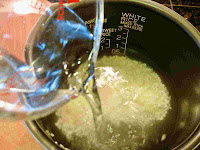While today this opaque, white drink is more strongly associated with winter, especially with the New Year's holiday and Hinamatsuri Doll (Girls' Day) Festival on March 3, it used to be a health tonic in summer. Typically served hot in winter and cold in summer, often with ginger juice, this super healthy tonic contains nine essential amino acids and over 100 enzymes. Rich in glucose (20%) and oligosaccharide, it also contains vitamins (B1, B2, B6, B12, pantothenic acid, inositol and biotin). Amazake has been called a “drinkable I.V.,” which shows how nutritional it is.
Koji rice malt amazake can be made with or without rice. When using rice, it is first cooked as regular steamed rice or soft like rice porridge. Below, I make rice porridge with regular and sweet rice (more sweet rice results in a sweeter taste), and adjust the temperature and water level when adding koji rice malt before incubation at 60 C/140 F using the “keep warm” function of a rice cooker. The amazake base starts to smell and taste sweet after 4 hours or so, and I stop the incubation process after 5 or 6 hours. Incubating longer will result in a sweeter taste. To drink as amazake, I dilute the base with an equal amount of water (or more), and squeeze grated ginger.
<Ingredients>
90-100 cc regular rice and mochigome sweet rice in combination (equal parts in photo)
500 cc water
100-150 g koji rice malt (150 g dry type in photo)
300-350 cc water
<Directions>
1.
Rinse regular and sweet rice.
Add 500cc water, and cook porridge.
(Porridge can be cooked in a pot. Mixing in water to steamed rice also works fine.)
2.
Remove pot from the rice cooker (or remove pot from heat), and let cool to at least 70 C/160 F.
(The porridge was about 80 C/176 F immediately after removing from the rice cooker, and its temperature lowered to 76C/169F in several minutes.)
If in a hurry, pour some cold water to lower the porridge temperature.
3.
Add koji rice malt, and mix.
4.
Heat water to 60-65 C/140-149 F in microwave (80 seconds for 300 cc), and add to rice malt porridge until it is covered,
Set in rice cooker, and press the thermal function (“keep warm”) button.
Keep the rice cooker cover open, place a cloth, and wait for 4+ hours.
Stir once or twice so that rice malt porridge maintains a more even temperature during incubation.
(6 hours later in photo: smells and tastes very sweet!)
Amazake no moto base is ready.
5.
(Optional: see the last note below.) When desirable sweetness is achieved, press cook button, and cook until rice malt porridge (now amazake base) starts to boil. If your rice cooker does not let you cook with the cover open, transfer amazake base to a pot, and cook until almost boiling (90 C/195 F).
Cool, and keep refrigerated.
6.
To drink, puree (optional), add water, heat (in winter), and squeeze in ginger juice.
<Notes>
- You can use leftover steamed rice by pouring water and simmering, instead of making porridge from scratch.
- The ideal temperature range for incubation is 55-60 C/131-140 F. Koji rice malt’s enzymes are damaged if kept at 70 C/160 F for more than 30 minutes.
- Depending on the rice cooker, the thermal function temperature may be much lower and the cover may need to be closed somewhat to keep the temperature optimal.
- Thermal pots, yogurt makers, heated blankets, a kotatsu heated covered table, and insulated boxes with hot water bottles are also suggested for incubation.
- There is another type of amazake made with sakekasu sake lees, which contain alcohol, and sugar or a sweetener is added.
- Amazake literally means sweet sake; when made with koji rice malt, amazake is virtually free of alcohol (below 1% even when alcohol starts to form during incubation).
- Keeps in the fridge for 10-14 days. Throw it away when it starts to taste sour. Amazake base can also be frozen.
- Process 5 (boiling finished amazake base) is optional. It is to stop incubation and make the amazake keep longer. However, the nutritional value of amazake base or amazake is higher without heating. Even when not boiled, amazake base should be OK in the fridge for a week.
Recipes with amazake no moto
- Amazake-iri sobako pankeeki / buckwheat pancakes with amazake
- Amazake chokoreeto keeki / chocolate cake with amazake
(Last updated: July 27, 2017)





















No comments:
Post a Comment